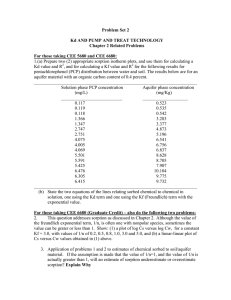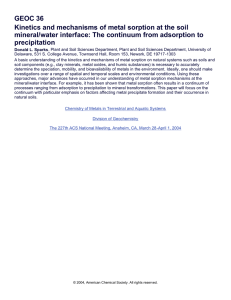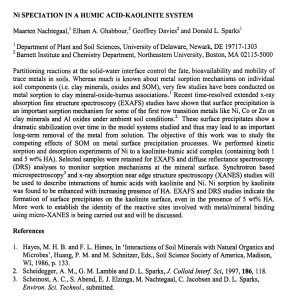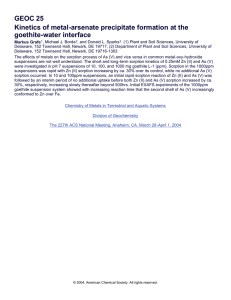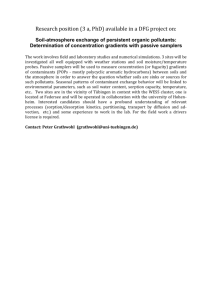Interactions Between Cations and Nanoparticulate Layered Mn Oxides -- A... Atomic Pair Distribution Functions (PDF) Analysis
advertisement
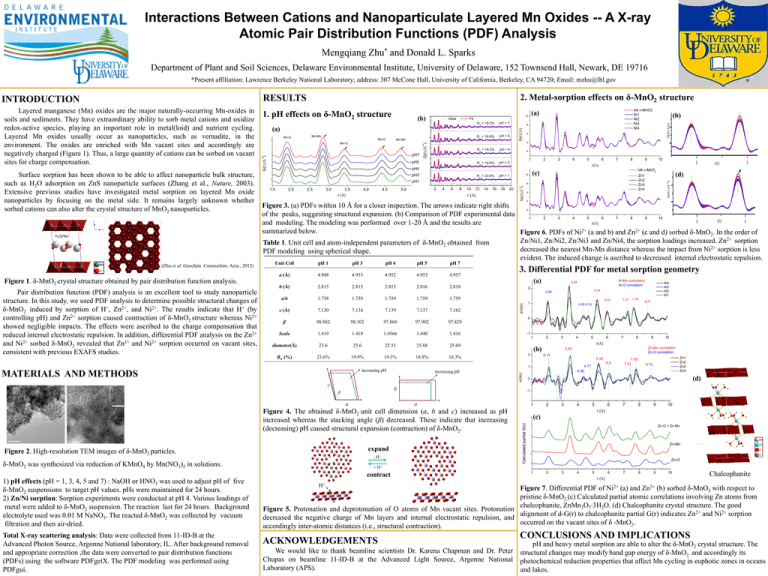
Interactions Between Cations and Nanoparticulate Layered Mn Oxides -- A X-ray Atomic Pair Distribution Functions (PDF) Analysis Mengqiang Zhu* and Donald L. Sparks Department of Plant and Soil Sciences, Delaware Environmental Institute, University of Delaware, 152 Townsend Hall, Newark, DE 19716 *Present affiliation: Lawrence Berkeley National Laboratory; address: 307 McCone Hall, University of California, Berkeley, CA 94720; Email: mzhu@lbl.gov 2. Metal-sorption effects on δ-MnO2 structure H2O/Na+ (Zhu et al. Geochim .Cosmochim. Acta., 2012) Figure 1. δ-MnO2 crystal structure obtained by pair distribution function analysis. Pair distribution function (PDF) analysis is an excellent tool to study nanoparticle structure. In this study, we used PDF analysis to determine possible structural changes of δ-MnO2 induced by sorption of H+, Zn2+, and Ni2+. The results indicate that H+ (by controlling pH) and Zn2+ sorption caused contraction of δ-MnO2 structure whereas Ni2+ showed negligible impacts. The effects were ascribed to the charge compensation that reduced internal electrostatic repulsion. In addition, differential PDF analysis on the Zn2+ and Ni2+ sorbed δ-MnO2 revealed that Zn2+ and Ni2+ sorption occurred on vacant sites, consistent with previous EXAFS studies. Data Fit Rw = 18.3% pH = 7 Rw = 18.8% pH = 5 (a) Mn-O Mn-Mn 4 0 pH5 Rw = 19.9% pH = 4 -4 1 pH = 3 Rw = 23.6% 12 pH = 1 pH1 3.0 3.5 r (Å) 4.0 4.5 2 5.0 4 6 8 10 12 14 16 18 20 r (Å) 8 9 10 2 (c) Zn1 Zn2 Zn3 Zn4 r(Å) 3 (d) 4 0 -4 Unit Cell a (Å) pH 1 pH 3 4.948 pH 4 4.953 4.952 pH 5 4.953 pH 7 4.957 3. Differential PDF for metal sorption geometry (a) b (Å) 2.815 2.815 2.815 2.816 2.818 Ni-Mn correlation Ni-O correlation 3.48 2 a/b c (Å) 1.758 1.759 7.130 1.759 7.134 7.139 1.759 7.137 1.759 7.162 β 98.882 98.102 97.868 97.902 97.829 Scale 1.419 1.419 1.4566 1.440 1.416 diameter(Å) 23.6 25.6 25.51 25.88 25.69 Rw (%) 23.6% 19.9% 19.3% 18.8% 18.3% 6.01 1 increasing pH 4.40 4.74 1 2 3 5 6 7 8 9 10 (b) 2 Zn-Mn correlation Zn-O correlation 3.50 2.11 5.34 6.0 4.77 4.36 7.78 7.41 Zn1 Zn2 Zn3 Zn4 8.75 (d) 0 expand - H+ 1 2 3 4 5 6 7 8 9 10 r (Å) (c) Calculated partial G(r) 50nm δ-MnO2 was synthesized via reduction of KMnO4 by Mn(NO3)2 in solutions. 4 -1 Figure 4. The obtained δ-MnO2 unit cell dimension (a, b and c) increased as pH increased whereas the stacking angle (β) decreased. These indicate that increasing (decreasing) pH caused structural expansion (contraction) of δ-MnO2. Figure 2. High-resolution TEM images of δ-MnO2 particles. 8.71 r(Å) a a 7.79 -1 b β 7.37 0 d-G(r) increasing pH Ni4 Ni3 Ni2 Ni1 5.34 2.06 c Zn-O + Zn-Mn Zn-Mn Zn-O + H+ contract Total X-ray scattering analysis: Data were collected from 11-ID-B at the Advanced Photon Source, Argonne National laboratory, IL. After background removal and appropriate correction ,the data were converted to pair distribution functions (PDFs) using the software PDFgetX. The PDF modeling was performed using PDFgui. 7 Figure 3. (a) PDFs within 10 Å for a closer inspection. The arrows indicate right shifts of the peaks, suggesting structural expansion. (b) Comparison of PDF experimental data 1 2 3 4 5 6 7 8 9 10 r(Å) 2 3 r(Å) and modeling. The modeling was performed over 1-20 Å and the results are summarized below. Figure 6. PDFs of Ni2+ (a and b) and Zn2+ (c and d) sorbed δ-MnO2. In the order of 2+ sorption Zn/Ni1, Zn/Ni2, Zn/Ni3 and Zn/Ni4, the sorption loadings increased. Zn Table 1. Unit cell and atom-independent parameters of δ-MnO2 obtained from 2+ sorption is less decreased the nearest Mn-Mn distance whereas the impact from Ni PDF modeling using spherical shape. evident. The induced change is ascribed to decreased internal electrostatic repulsion. MATERIALS AND METHODS 1) pH effects (pH = 1, 3, 4, 5 and 7) : NaOH or HNO3 was used to adjust pH of five δ-MnO2 suspensions to target pH values. pHs were maintained for 24 hours. 2) Zn/Ni sorption: Sorption experiments were conducted at pH 4. Various loadings of metal were added to δ-MnO2 suspension. The reaction last for 24 hours. Background electrolyte used was 0.01 M NaNO3. The reacted δ-MnO2 was collected by vacuum filtration and then air-dried. 6 blk -MnO2 1 5nm 5 -2 2.5 4 8 G(r) (Å ) 2.0 3 r(Å) pH4 pH3 2 -2 -2 Rw = 19.3% G(r) (Å ) pH7 1.5 (b) -4 Mn-O G(r) (Å ) Mn-O Mn-Mn 8 G(r) (Å) (b) blk -MnO2 Ni1 Ni2 Ni3 Ni4 (a) 12 d-G(r) Surface sorption has been shown to be able to affect nanoparticle bulk structure, such as H2O adsorption on ZnS nanoparticle surfaces (Zhang et al., Nature, 2003). Extensive previous studies have investigated metal sorption on layered Mn oxide nanoparticles by focusing on the metal side. It remains largely unknown whether sorbed cations can also alter the crystal structure of MnO2 nanoparticles. 1. pH effects on δ-MnO2 structure G(r) (Å ) Layered manganese (Mn) oxides are the major naturally-occurring Mn-oxides in soils and sediments. They have extraordinary ability to sorb metal cations and oxidize redox-active species, playing an important role in metal(loid) and nutrient cycling. Layered Mn oxides usually occur as nanoparticles, such as vernadite, in the environment. The oxides are enriched with Mn vacant sites and accordingly are negatively charged (Figure 1). Thus, a large quantity of cations can be sorbed on vacant sites for charge compensation. G(r) (Å) RESULTS INTRODUCTION 1 2 3 4 5 6 7 8 9 10 r (Å) Chalcophanite H+ Figure 7. Differential PDF of Ni2+ (a) and Zn2+ (b) sorbed δ-MnO2 with respect to pristine δ-MnO2.(c) Calculated partial atomic correlations involving Zn atoms from chalcophanite, ZnMn3O7· 3H2O. (d) Chalcophanite crystal structure. The good Figure 5. Protonation and deprotonation of O atoms of Mn vacant sites. Protonation alignment of d-G(r) to chalcophanite partial G(r) indicates Zn2+ and Ni2+ sorption decreased the negative charge of Mn layers and internal electrostatic repulsion, and occurred on the vacant sites of δ -MnO2. accordingly inter-atomic distances (i.e., structural contraction). ACKNOWLEDGEMENTS We would like to thank beamline scientists Dr. Karena Chapman and Dr. Peter Chupas on beamline 11-ID-B at the Advanced Light Source, Argonne National Laboratory (APS). CONCLUSIONS AND IMPLICATIONS pH and heavy metal sorption are able to alter the δ-MnO2 crystal structure. The structural changes may modify band gap energy of δ-MnO2 and accordingly its photochemical reduction properties that affect Mn cycling in euphotic zones in oceans and lakes.
